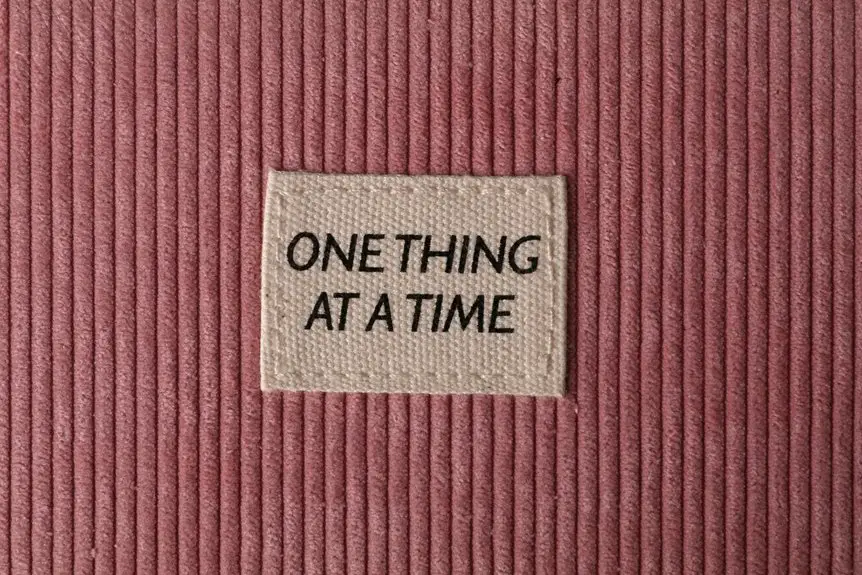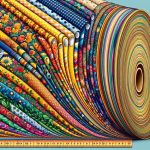When sewing with corduroy, you’ll want to buy at least 25% extra fabric to handle its thick texture, pattern matching, and shrinkage. Corduroy’s raised wales require extra yardage for alignment, and its tendency to shrink about 3-5% means pre-washing and careful measurement are key. Also, adjusting seam allowances and paying attention to nap direction helps keep your project looking polished. Keep scrolling to understand how fabric weight and garment type influence your yardage needs.
Table of Contents
Key Takeaways
- Add 10-20% extra fabric to accommodate the thickness and raised wales of corduroy for cutting and sewing.
- Allocate 10-15% additional fabric to allow for 3-5% shrinkage after pre-washing the corduroy fabric.
- Increase fabric yardage by 25-30% if pattern matching or aligning wales/stripes for a professional finish.
- Use larger seam allowances (at least 1/4 inch) to manage bulk and maintain proper pile direction in seams.
- Pre-wash fabric and measure post-wash length to ensure accurate fabric requirements and prevent fitting issues.
Understanding Corduroy Fabric Characteristics
Corduroy’s distinctive texture comes from its raised ridges, called wales, which give the fabric both durability and warmth. When you work with corduroy, you’ll notice these wales run lengthwise, creating a soft, ribbed surface.
The spacing between wales varies, affecting the fabric’s appearance and feel—fine wales are thinner and closer together, while wide wales are chunkier and more pronounced. Corduroy is usually made from cotton or cotton blends, providing breathability and comfort.
It has a bit of heft, so it drapes differently than lighter fabrics. You’ll find it’s sturdy and resists wear well, making it ideal for outerwear and pants. Understanding these characteristics helps you appreciate why corduroy behaves uniquely during cutting and sewing.
How Corduroy Texture Affects Fabric Requirements
Because the texture of corduroy features raised wales, you’ll need to account for extra fabric when planning your project. The pile adds thickness and directionality, which affects how pieces align and how much fabric you consume.
You’ll use more fabric to guarantee the wales run consistently across seams, preventing mismatched patterns or awkward texture shifts. Additionally, the nap causes the fabric to behave differently when cut, so you can’t just flip pieces around without altering appearance or feel.
Expect to add at least 10-20% more yardage than you’d for smooth fabrics to accommodate these factors. By anticipating these needs, you’ll avoid last-minute shortages and achieve a professional finish that showcases corduroy’s unique texture to its best advantage.
Determining Extra Yardage for Pattern Matching
When you match patterns on corduroy, you’ll need to add extra fabric to assure the wales align perfectly across seams.
Start by examining your pattern pieces and identify where the stripes or wales must line up. Add at least 25-30% more yardage than your standard requirement to allow for shifting the fabric to align these lines.
Check your pattern pieces and add 25-30% more fabric to perfectly align corduroy wales.
This extra fabric gives you flexibility when cutting, so you can adjust pieces for a seamless match. Remember, you might need even more if your pattern is complex or involves multiple seams with pattern matching.
Always lay out your pieces carefully, considering how the stripes will flow from one piece to another. Planning ahead prevents fabric waste and assures your finished project looks polished and professional.
Accounting for Nap Direction in Corduroy
Matching the wales takes extra fabric and careful planning, but you also need to contemplate the direction of the nap on corduroy.
The nap refers to the texture’s raised fibers, which reflect light differently depending on the angle. When you cut pattern pieces, make certain all lay in the same nap direction to avoid color and shading inconsistencies.
Cutting pieces with mixed nap directions can cause one side to look darker or lighter, disrupting the garment’s uniform appearance. Always lay your pattern pieces in the same orientation, usually with the nap running downward.
This approach means you might need more fabric than a non-nap fabric, so factor that into your yardage calculations before cutting to guarantee a smooth, consistent finish.
Adjusting Seam Allowances for Corduroy Projects
When sewing with corduroy, you’ll need to adjust your seam allowances to handle its extra bulk.
Giving yourself a bit more room can prevent seams from becoming too thick and hard to manage.
Let’s look at how to modify those allowances for a smoother finish.
Seam Allowance Adjustments
Three key factors influence how you should adjust seam allowances for corduroy projects: fabric thickness, pile direction, and garment fit.
Since corduroy is thicker than many fabrics, you’ll want to add at least 1/4 inch extra to your seam allowances to accommodate bulk and prevent tight seams.
Pay attention to the pile direction—seams sewn against the pile can shift or create uneven edges, so slightly wider allowances help maintain alignment during stitching.
Also, if your garment requires a snug fit, you might reduce seam allowances a bit to avoid added bulk, but for looser styles, adding more seam allowance improves comfort and durability.
Always mark allowances clearly and test on scraps to verify your adjustments achieve the best balance between structure and flexibility.
Handling Corduroy Bulk
Though corduroy’s texture adds charm, its bulk can make seams tricky to manage. When sewing, you’ll want to adjust your seam allowances slightly wider than usual to accommodate the thickness without creating too much tension. This helps prevent puckering and guarantees smoother seams.
Additionally, trimming seam allowances or grading them after stitching reduces excessive bulk, making your project more comfortable and professional-looking. Press seams carefully, using a tailor’s ham or seam roll to maintain the fabric’s pile direction and avoid flattening the ridges.
Planning for Fabric Shrinkage and Pre-Washing
Before you start sewing, remember that corduroy can shrink after washing, so pre-washing your fabric is a smart move.
This step helps you avoid surprises and guarantees your final piece fits just right.
Make sure to adjust your fabric measurements accordingly to account for any shrinkage.
Understanding Corduroy Shrinkage
When you work with corduroy, you’ll want to account for its natural tendency to shrink, especially after the first wash. This shrinkage varies depending on fiber content and fabric weight, but generally, corduroy can reduce in size by about 3-5%.
Ignoring this can lead to ill-fitting garments or projects that come up short. To prevent surprises, always factor in extra fabric—typically an additional 10-15%—when purchasing your material. This buffer helps guarantee you have enough even after shrinkage occurs.
Benefits of Pre-Washing
Accounting for corduroy’s shrinkage is important, but you can manage it more effectively by pre-washing your fabric.
Pre-washing helps you avoid unexpected changes in size after sewing, ensuring your finished garment fits perfectly. It also removes any chemicals or sizing agents applied during manufacturing, which can affect fabric texture and color.
When you pre-wash, the fabric relaxes, softens, and reveals its true weight and drape, allowing you to sew with greater accuracy. Skipping this step risks distortion or uneven seams later on.
To pre-wash corduroy, use cold water and a gentle cycle, then air dry or tumble dry low to minimize further shrinkage. This simple step saves you headaches and helps you create a polished, professional-looking project.
Adjusting Fabric Measurements
Three key factors influence how you should adjust your fabric measurements for corduroy: shrinkage, pre-washing effects, and the fabric’s nap.
Since corduroy tends to shrink, always buy extra fabric—typically 10-15% more than your pattern calls for.
Pre-washing your fabric before cutting helps prevent surprises after sewing, but it can alter the fabric’s dimensions. Measure the washed fabric carefully to confirm how much it has shrunk.
Remember, the nap direction affects how you lay out your pattern pieces, so factor that into your calculations.
Tips for Efficient Fabric Layout and Cutting
Laying out corduroy fabric efficiently starts with understanding its unique texture and nap direction. Always align all pattern pieces in the same nap direction to prevent color and texture inconsistencies.
Use weights instead of pins to avoid damaging the fabric’s ridges. Before cutting, smooth the fabric gently without stretching to maintain its shape. Position larger pattern pieces first, then fit smaller ones into leftover spaces to minimize waste.
Keep your cutting surface clean and flat to avoid snagging the fabric. Use sharp scissors or a rotary cutter for clean edges, reducing fraying. Mark pattern outlines with tailor’s chalk or fabric markers, as pins can distort corduroy.
Taking these steps guarantees precise cuts and maintains the fabric’s integrity for professional-looking results.
Choosing the Right Corduroy Weight and Width
Choosing the right corduroy weight and width plays an essential role in how your finished project will look and feel. Lightweight corduroy suits garments like shirts, while heavyweight works best for durable items like jackets. Width affects how much fabric you need and influences pattern matching, especially with wide wale corduroy.
| Weight | Typical Use |
|---|---|
| Lightweight | Shirts, blouses |
| Medium | Pants, skirts |
| Heavyweight | Jackets, upholstery |
| Extra Heavy | Workwear, outerwear |
| Width | Impact on Project |
| 44-45 inches | Standard patterns |
| 54-60 inches | Larger patterns, less seams |
| Narrow | Requires more fabric |
| Wide | Easier pattern layout |
Picking the right combination helps you minimize fabric waste and achieve the desired drape and durability.
Common Mistakes to Avoid When Buying Corduroy
When buying corduroy, don’t underestimate how much it can shrink after washing.
You’ll also want to pay close attention to the nap direction, as ignoring it can affect how your finished piece looks.
Avoid these common mistakes to guarantee your project turns out just right.
Misjudging Fabric Shrinkage
Although corduroy offers durability and style, you might overlook how much it can shrink after washing. This mistake can lead to garments that end up too small or ill-fitting. To avoid this, always pre-wash your fabric before cutting.
Keep in mind that corduroy, especially cotton blends, tends to shrink between 3-5%. If you skip pre-washing, your finished project mightn’t fit as expected.
Also, consider buying extra fabric to accommodate potential shrinkage. This way, you won’t run short after laundering.
Overlooking Nap Direction
Why does nap direction matter so much with corduroy? Because the fabric’s texture reflects light differently depending on the pile’s orientation.
If you overlook nap direction when cutting your pieces, your garment can end up with uneven shading or a patchy look. To avoid this, always lay out your pattern pieces so the nap runs in the same direction. This guarantees a consistent appearance and a professional finish.
Remember, nap affects how the fabric feels too; mixing directions can cause sections to feel rough or smooth inconsistently.
When buying extra fabric, factor in the need to align all pieces with the nap. Ignoring this detail wastes material and compromises your project’s quality, so don’t skip this vital step.
Calculating Fabric Needs Based on Garment Type
Since corduroy comes in various widths and pile heights, calculating fabric needs depends heavily on the type of garment you plan to sew.
Different garments demand different amounts of fabric, especially when considering seam allowances and pattern matching for the pile. For example:
- Jackets require extra fabric to accommodate bulk and lining.
- Pants need enough fabric for pattern alignment and potential shrinkage.
- Skirts often call for additional yardage for pleats or gathers.
- Shirts typically use less fabric but still require attention to nap direction.
When planning, always add at least 10-20% more fabric than the pattern suggests to account for pile direction and matching.
This way, you’ll avoid shortages and guarantee your finished garment looks polished and professional.
Frequently Asked Questions
Can Corduroy Be Sewn With a Regular Sewing Machine Needle?
You can sew corduroy with a regular sewing machine needle, but it’s better to use a denim or heavy-duty needle to avoid skipped stitches and fabric damage. Make sure to adjust your machine settings for thicker fabric.
What Thread Type Works Best for Sewing Corduroy?
When it comes to sewing corduroy, you’ll want to use a strong polyester or cotton-wrapped polyester thread. It’s the best bet to hold seams tight without breaking, so you won’t be caught flat-footed mid-project.
How Do I Remove Lint and Fuzz From Corduroy After Sewing?
You can remove lint and fuzz from corduroy by gently using a lint roller or sticky tape. For tougher fuzz, try a fabric shaver or a soft brush. Avoid harsh rubbing to keep the fabric smooth.
Is It Necessary to Use Interfacing With Corduroy Fabric?
You don’t always need interfacing with corduroy, but it’s helpful for added structure, especially in collars or cuffs. If your fabric is thick and stable, you can skip it. Otherwise, go ahead and use interfacing.
Can Corduroy Be Ironed Without Damaging the Texture?
Don’t you want to keep your corduroy looking great? You can iron it, but use a low heat setting and press gently with a cloth on top. Avoid direct contact to protect the texture’s softness.






